US Bomber Crash 1944 at Greatstone
In the car park in Greatstone, there is a memorial to a downed aircraft on Greatstone beach from World War Two. The memorial has taken various forms over the years, with the latest (2022) shown on the right.
An earlier version, August 2010 is also shown.
The memorial was set up and maintained by local resident Colin Clayton, in memory of the officers and crew of the B24J Liberator Bomber 42-95191, which crashed landed on 20 June 1944 into heavy sea's close inshore at Greatstone, almost opposite the Jolly Fisherman.
The Liberator Bomber (see video below) was part of a force of 2nd Divisions B24 bombing a NOBALL (VI) launching sites in the Pas-de-Calais area. Liberator Bomber 42-95191. It was flown by Lt Charles Stevens and crew and took a direct hit from an 88mm shell which blew away most of the nose section in front of the pilot's compartment.
Both the Navigator, Lt Harold R Meng, and the Bombardier, Lt William F Weck, were killed instantly, Meng's body being blown out of the aircraft by the explosion.
Two engines were functioning as the B24 left the target area, and a third failed over the channel. The remaining engine began to lose power as the B24 neared the Kent coast. The pilot brought the aircraft in for a crash landing.
Unfortunately, S/Sgt Thomas E Fulbright and S/Sgt Bernard E Peak (Gunners) both elected to bale out before the forced landing, delayed opening their parachutes, and were killed instantly when they fell onto the sands.
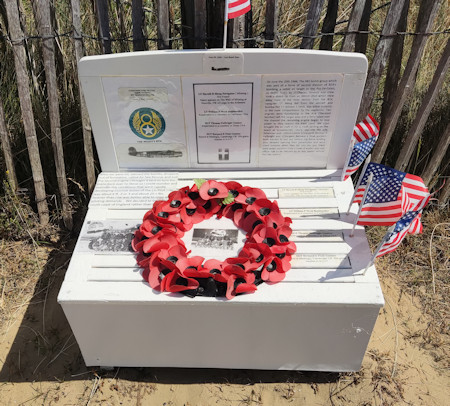
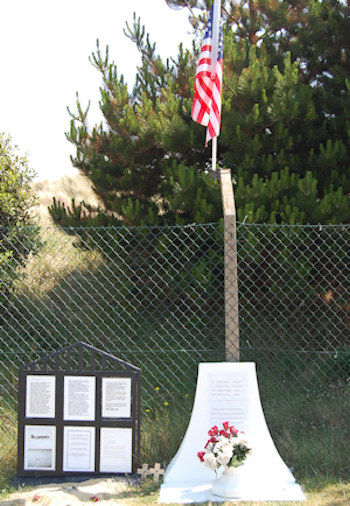
US Memorial In Greatstone Car Park
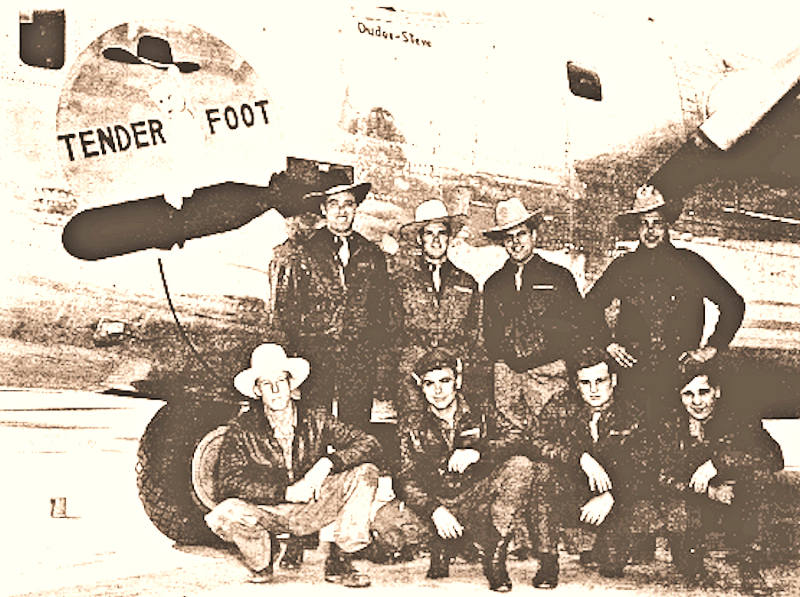
Crew of the bomber L to R: Standing: Charles Stevens (Pilot) Bill Holm (Co-Pilot) Harold Meng (Navigator) Willam Weck (Bombardier)Kneeling:
Leon Boersma (Engineer) Thomas Fulbright (Wing Gunner) Joth House (Radio Operator) Bernard Peake (Tail Gunner)
Richard Stevens, son of Lt Charles Stevens, writes:
" There were two missions on the 20th, and the flak was " the heaviest most of the guys have seen yet." HEAVENLY BODY (42-110155, 1st Lt. Dudley E. Friday) was hit by a shell that came up through the flight deck and went out the top of the fuselage, taking the radio operator’s seat with it and leaving a hole nearly two feet in diameter.
Fortunately, the shell didn't burst and no one was injured. First Lt. Charles Stevens' crew in 42-95171 was not so lucky. One burst of flak shot away the entire nose section, instantly killing the navigator, Lt. Harold R. Meng, and the Bombardier, Lt. William F. Weck.
The plane left the target area with two engines gone, a third was lost over the Channel and the remaining engine was losing power as Stevens brought the wreck in."
Extract from First Sgt's Diary (ground maintenance crew):
" Stevens made a magnificent one-engine crash landing on the beach near Dover, but Fulbright (S/Sgt. Thomas E. Fulbright) and Peak (S/Sgt. Bernard E. Peak) jumped before the landing and delayed their chutes too long. Both were instantly killed. Meng's body blew right out of the ship when the flak hit. Stevens came back yesterday, is taking it hard.
Larry Silk (S/Sgt. Lawrence J. Silk) on Strain's crew got hit on the same mission and Jarrett (Sgt. Robert N. Jarrett), tail gunner with Lt. Boyd in JAIL BAIT, was killed by a hunk of flak that cut his spine in two. It's one hell of a war."
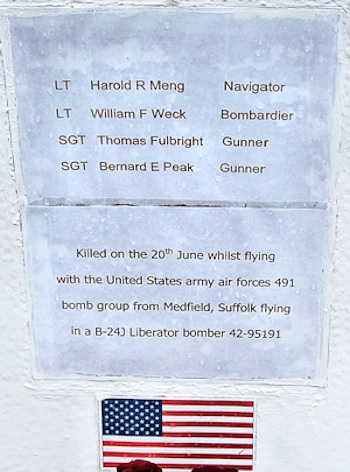
Text on the Memorial
A young RAF doctor, Sqn Ldr D D Morrell (see below), saw the bomber crash and attempted to wade out to it, but was driven back by the force of the waves and the strong current. A Mr J Frost of the local Civil Defence unit, took control of the situation.
An Army amphibious 'dukw' was commandeered to ferry Sqn Ldr Morrell to the aircraft and the other surviving crew were taken ashore. An officer was trapped in his seat by his legs and the rising tide, already up to his shoulders, threatened to drown him. Sqn Ldr Morrell repeatedly dived underwater to free him, succeeding in the nick of time.
Before he was taken ashore Sqn Ldr Morrell gave him morphia because of the appalling injuries to his legs. Sqn Ldr Morrell was later awarded the OBE for his 'outstanding courage and initiative'.
The aircraft could be seen on the sand at very low tides for a number of years, but has now disappeared buried under the sand.
There were 11 crew on board the B24J on the 20 June 1944. The time of the crash, according to the MACR (Missing Air Crew Report) was 2100 hours. The DBST then in use meant that it did not dark until 2230 hours.
The seven survivors were:
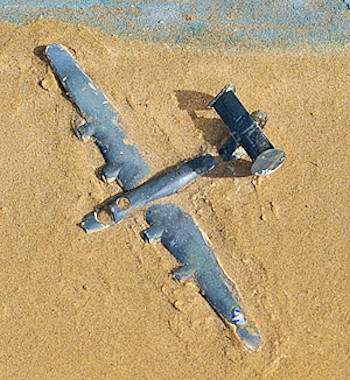
Model of the crashed plane as part of the memorial
1st Lt Charles W Stevens Pilot
2nd Lt William J Holm Co-pilot
2nd Lt Guy E Tweed Pilotage Navigator
T/Sgt Seth W House Radio Operator
T/Sgt Leon J Boersma Jr Engineer
S/Sgt William O Trebing Gunner
S/Sgt Richard E Black Gunner
Lt Stevens was shot down on 26 November 1944 with his second crew which contained none of the other members of his first crew he became a POW.
Guy Tweed, son of 2nd Lt Guy E Tweed, wrote in November 2009:
" My father, then 2nd Lt. Guy Tweed, was the pilotage navigator on the downed B-24J. He was also the officer who was trapped and nearly drowned in the fuselage. If Sqn. Ldr. D. D. Morrell is still alive, please give him my thanks for saving my father’s life.
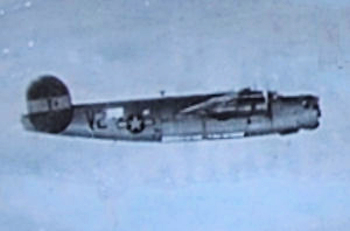
The B24J Liberator Bomber 42-95191 minus
its nose returning in 1944
Dr. Morrell may remember my father’s colourful language (so I was told) when he regained consciousness to discover his rescuers preparing to cut off his good leg in order to free him from the aircraft. Apparently, my father was persuasive, as the good leg survived – it was finally extracted from the wreckage by cutting his flight boot and then pulling his foot and leg free of the debris that had trapped him in the aircraft.
All in all, it was a pretty horrific day for my father, and it was his last combat action of the war. He spent the better part of the next two years convalescing from his injuries. If this incident had not occurred, though, I wouldn’t be here, as my father, after he returned to the States, met my mother (who was an Army nurse convalescing from rheumatic fever contracted in the jungles of Burma) at an Army Hospital (Crile Hospital – the forerunner of The Cleveland Clinic) in Cleveland, Ohio.
There is an exhibit that includes another description of this incident and the photograph in your article at the Eighth Air Force Museum in Savannah, Georgia. If you ever find yourself in that area, the chance, it is worth a visit. I am attaching a copy of another photo (see above right) of the aircraft taken from a longer range that I believe is included in that exhibit.
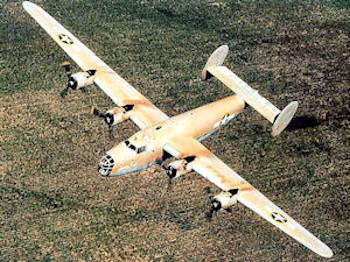
A B-24 Liberator Bomber
Thanks to all who have taken the time to remember this incident. We all have a great debt to those who fought the good fight so many years ago."
Dr David Duncan Morrell, then a Squadron Leader in the RAF, was a doctor based Biggin Hill in Kent. He was awarded the OBE for his 'outstanding courage and initiative' and received a superb silver covered cigarette box on which the famous Biggin Hill pilots had signed their names for him.
After the war, he became a family doctor in Chester-le-Street, Co. Durham, where he was held in high esteem by his patients, always being there when we needed.
Dr Morrell died in 1969 suddenly while on holiday from a heart attack. [Ack 58.]
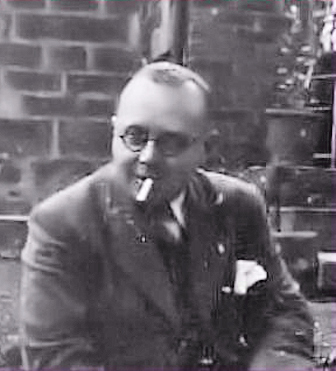
Dr David Morell OBE In 1948


















